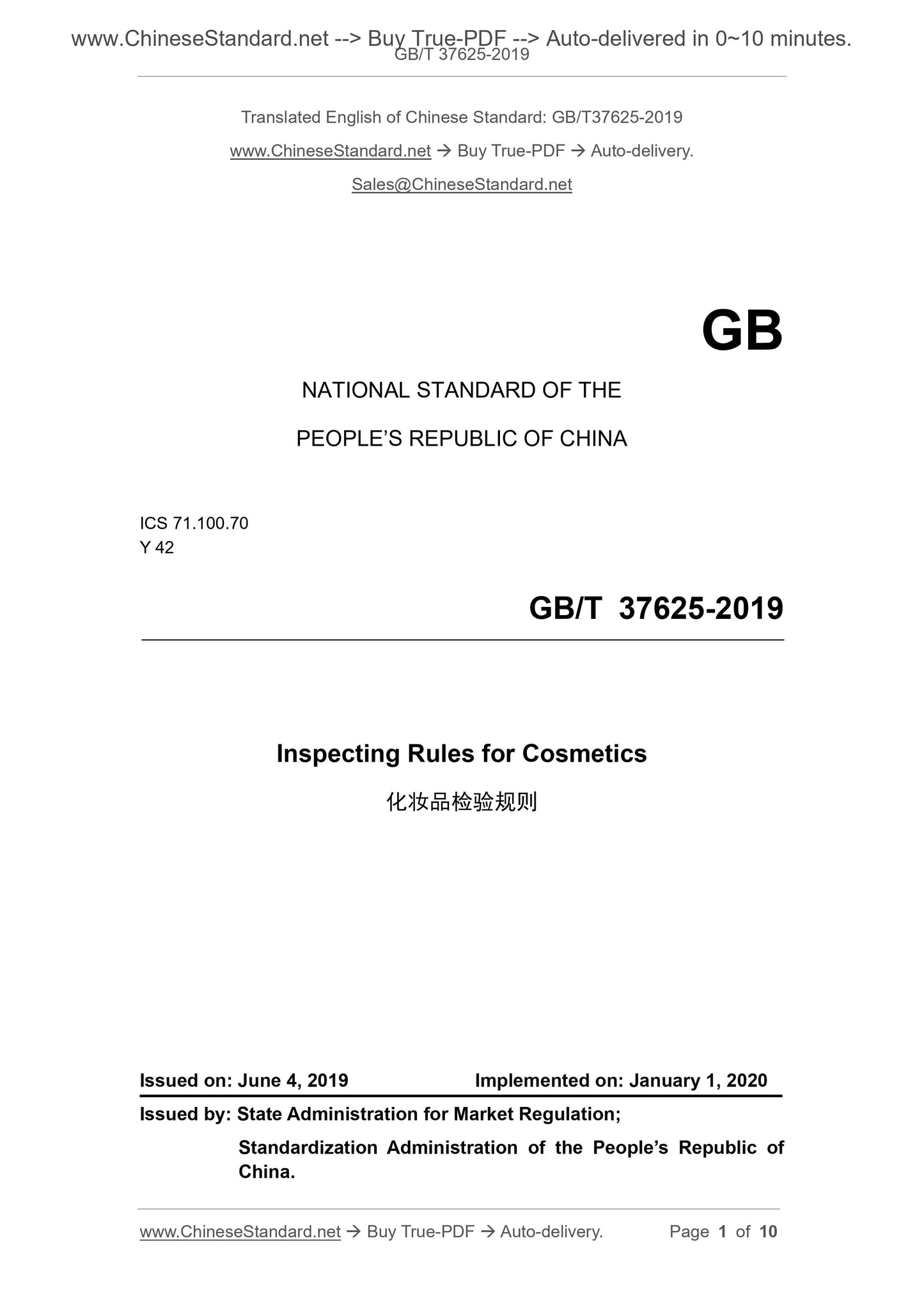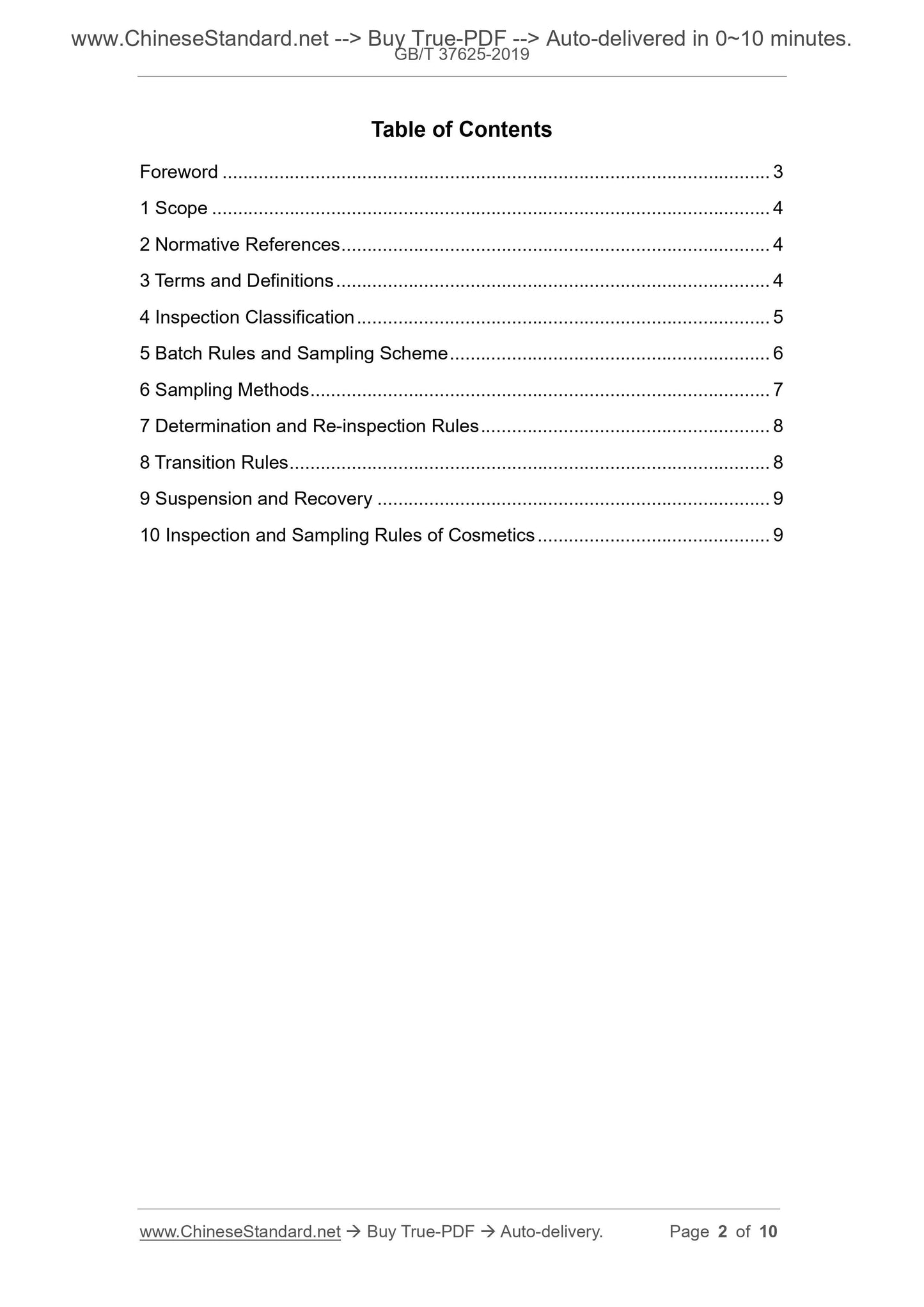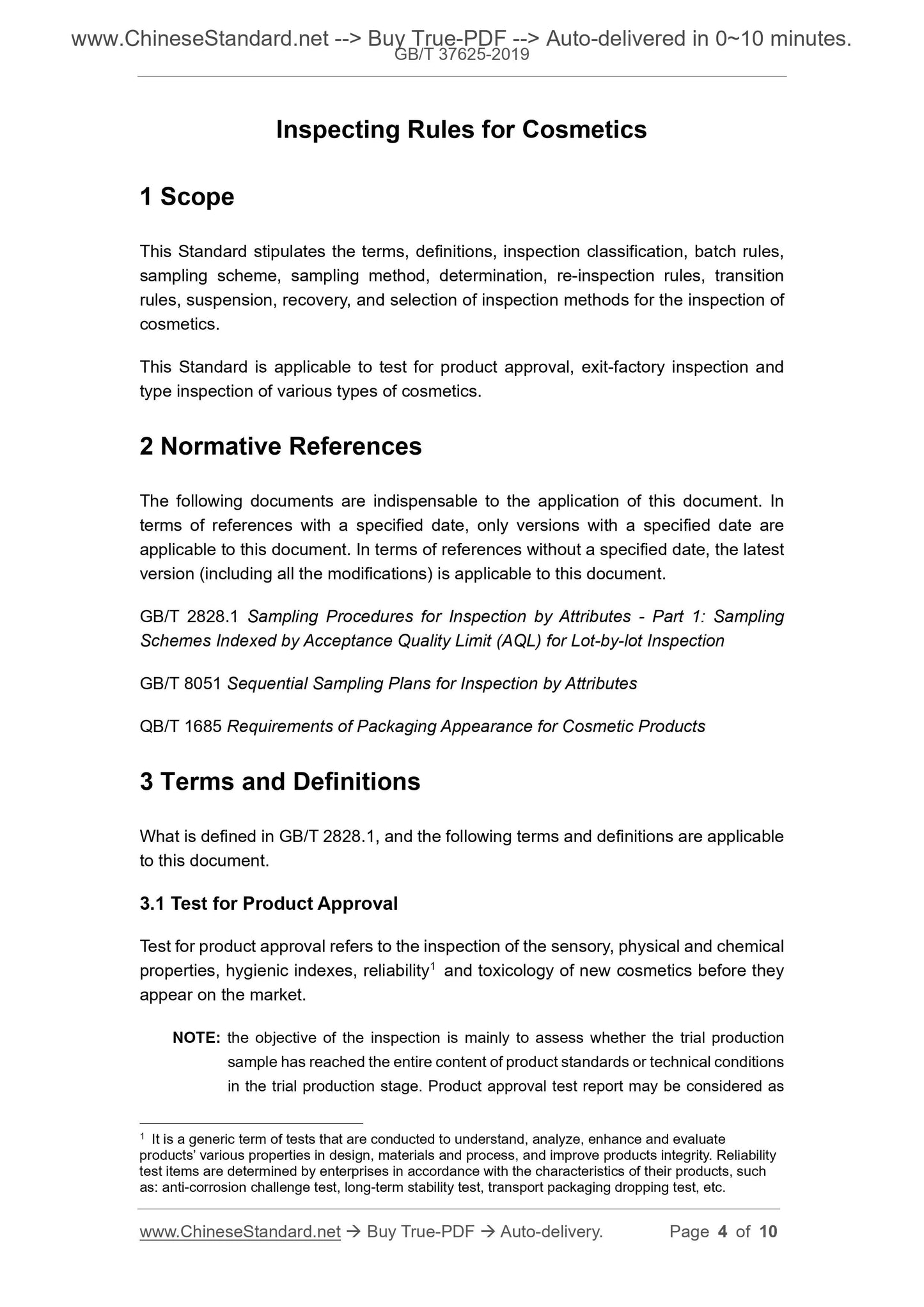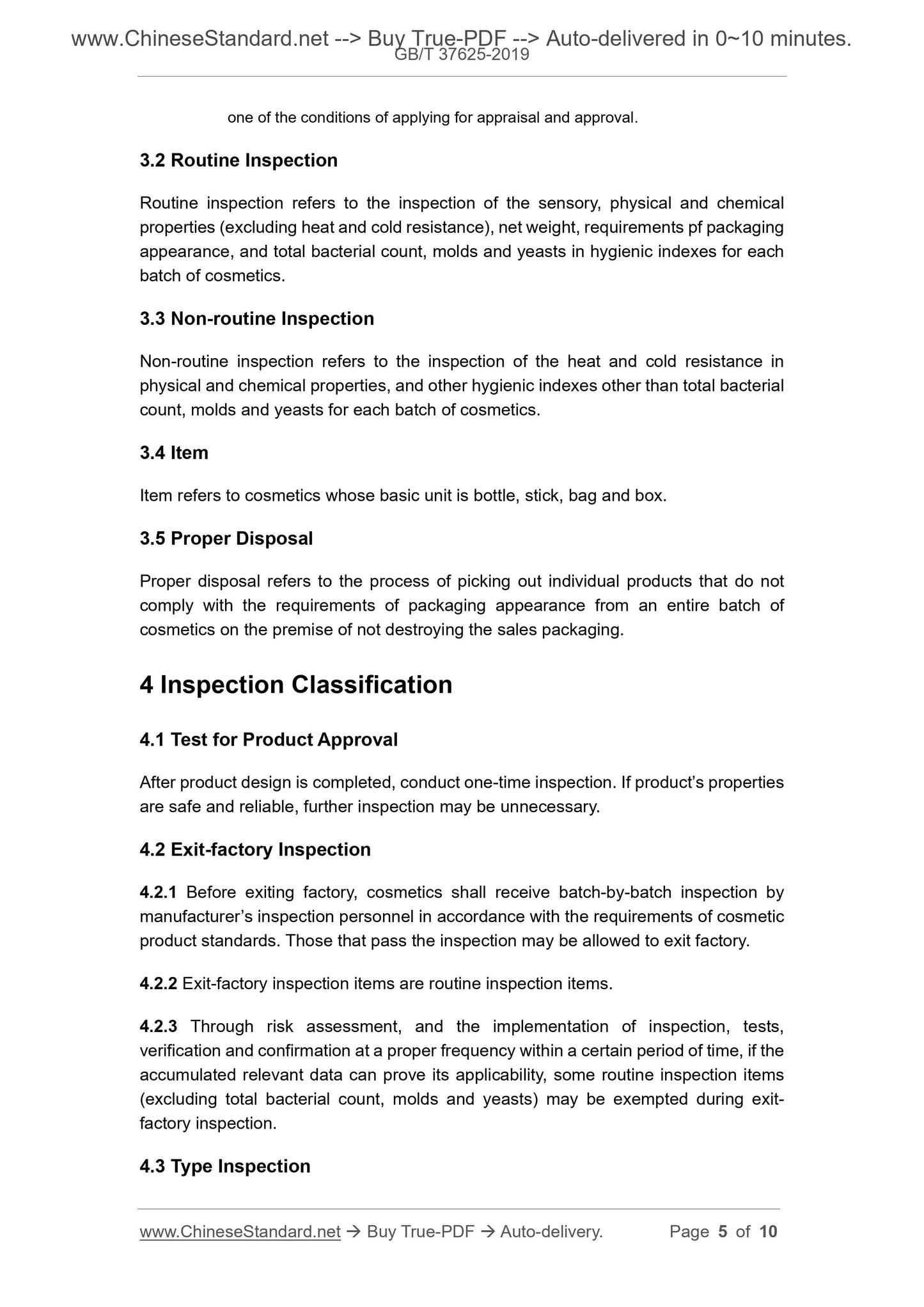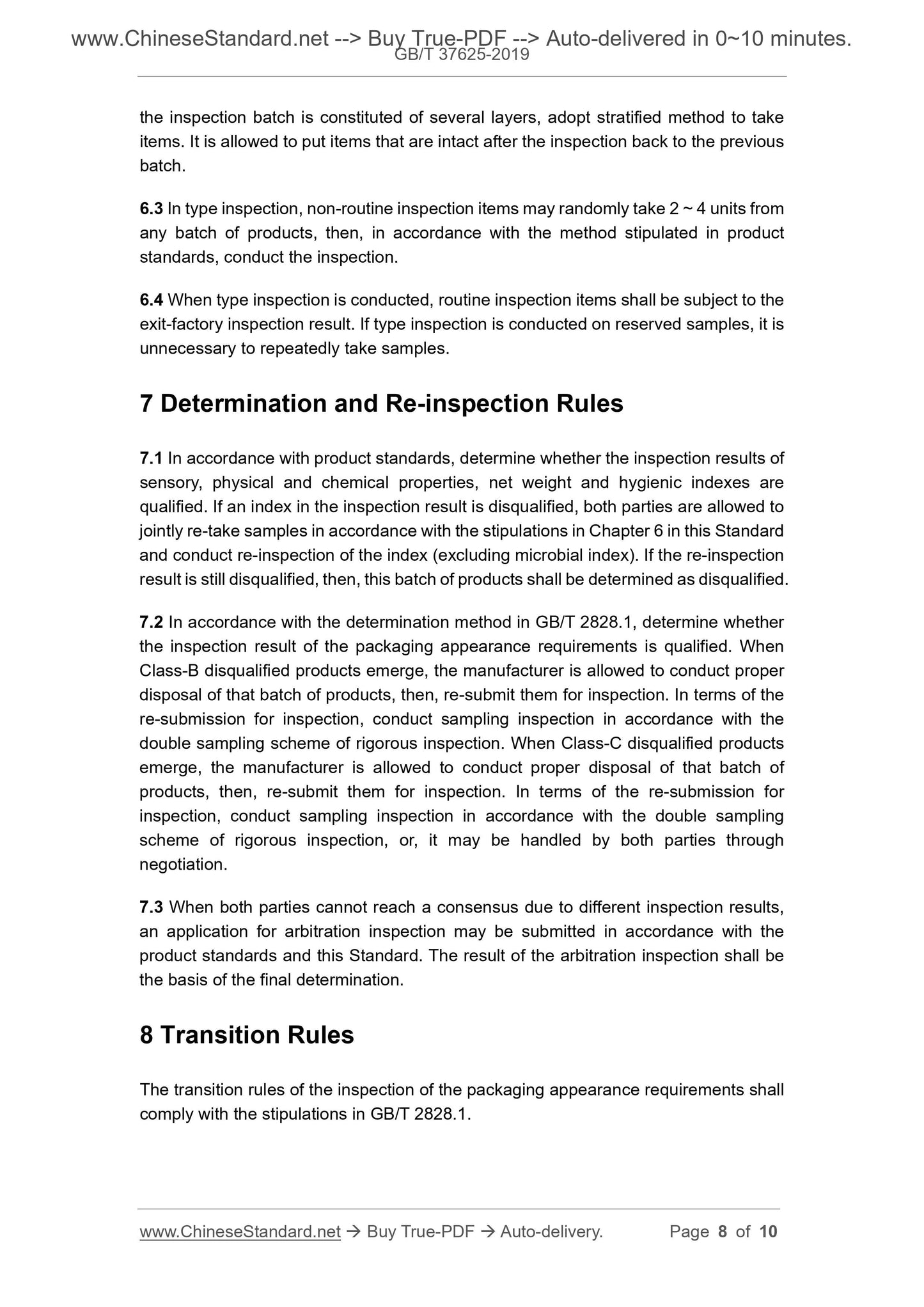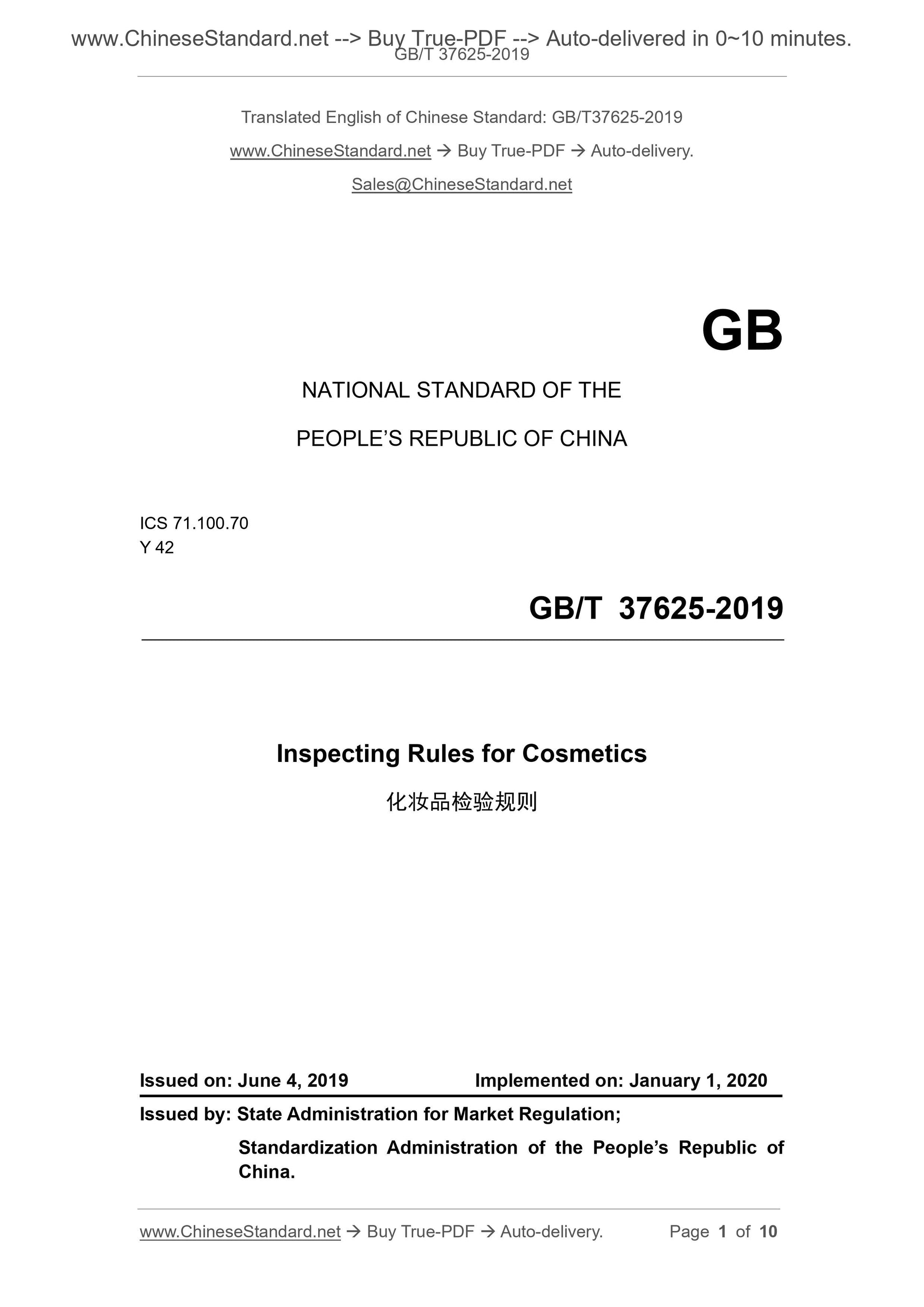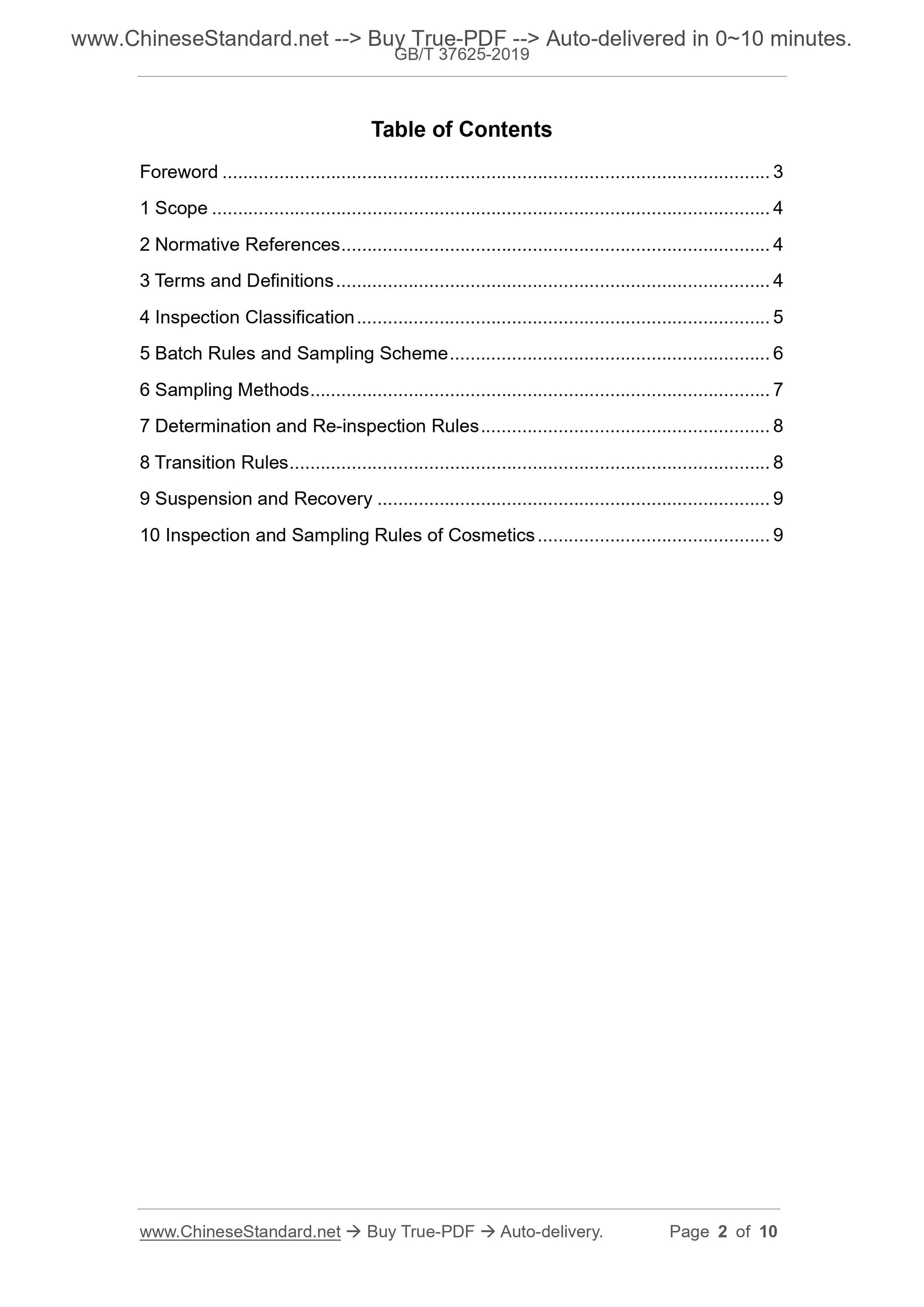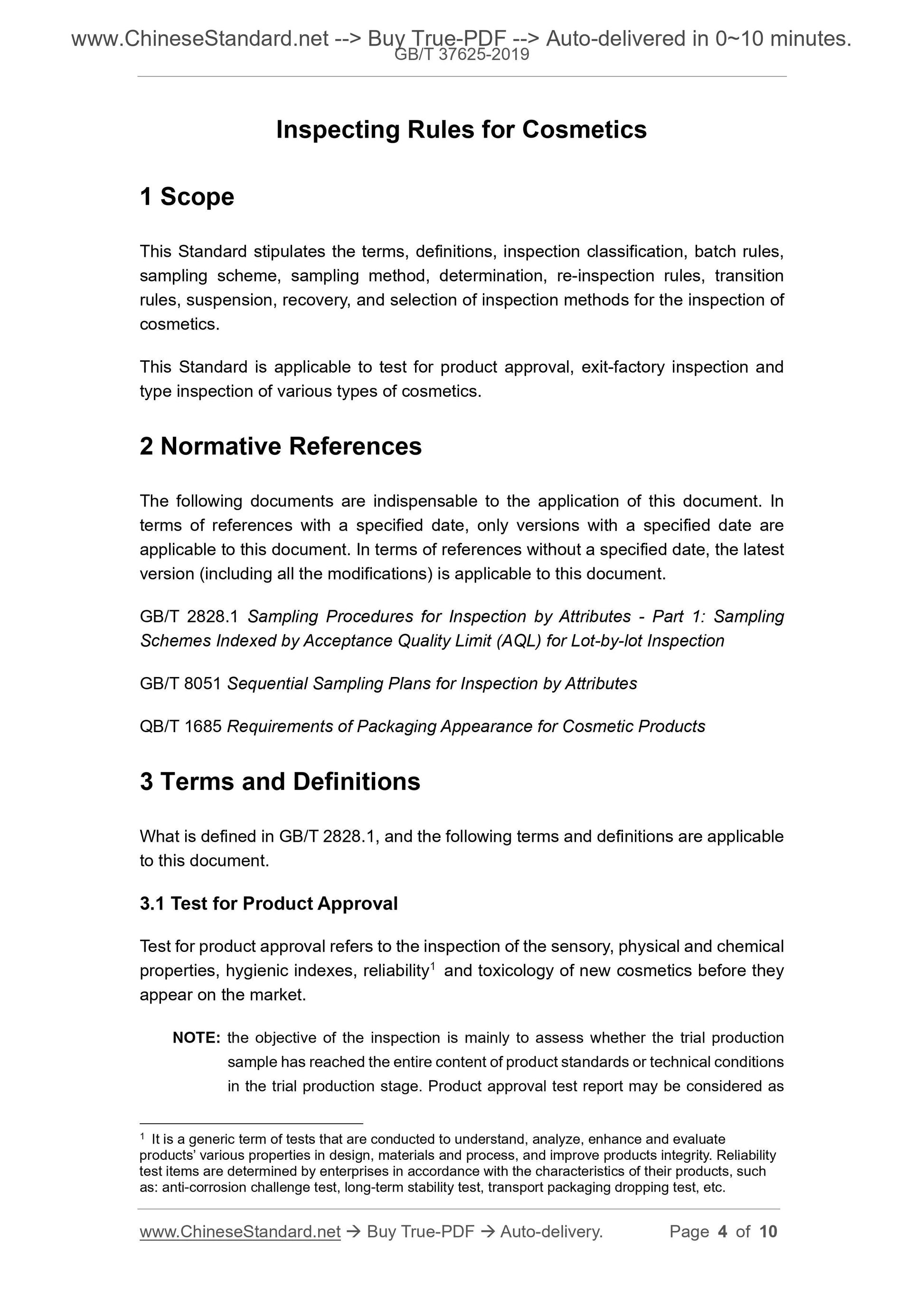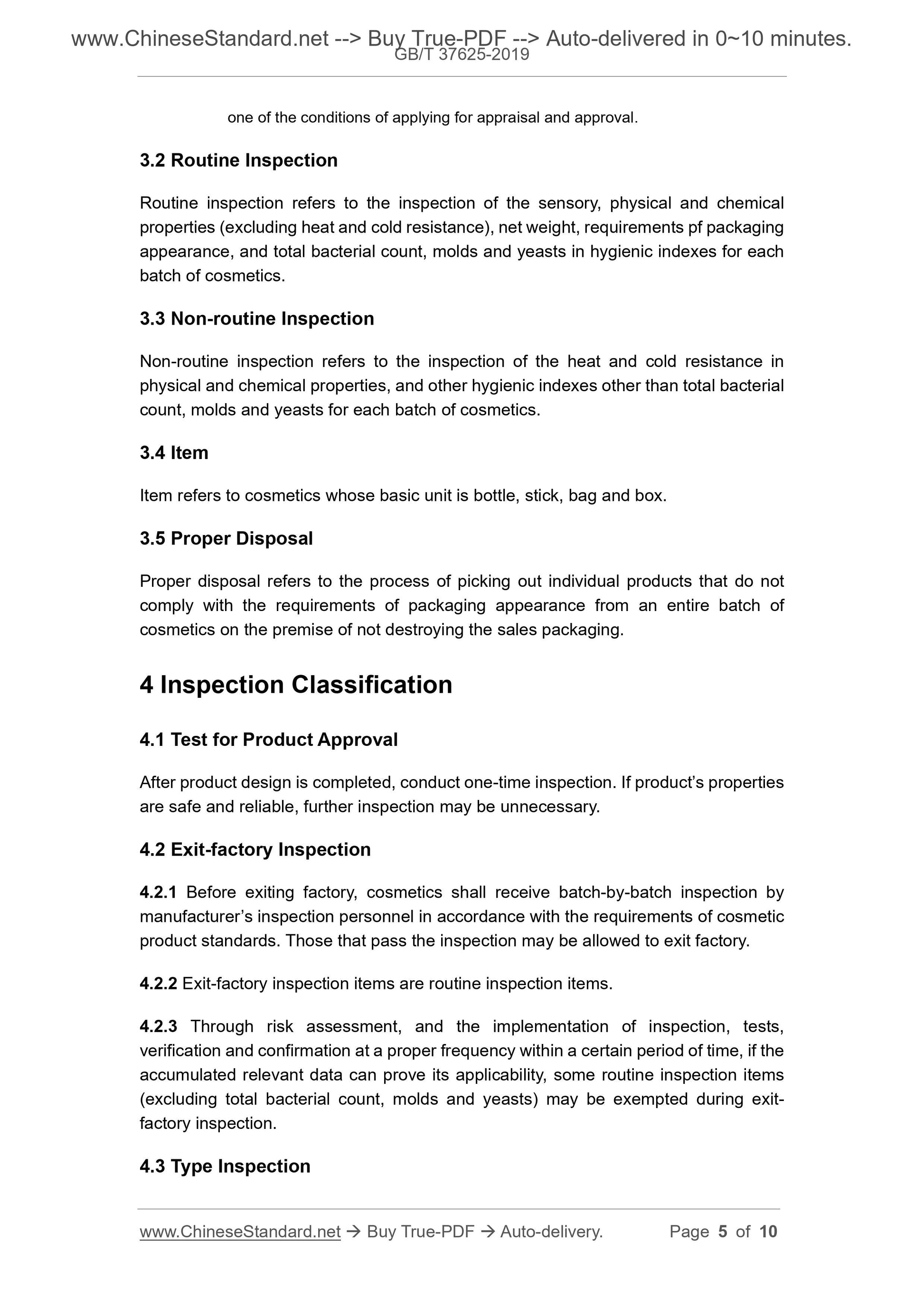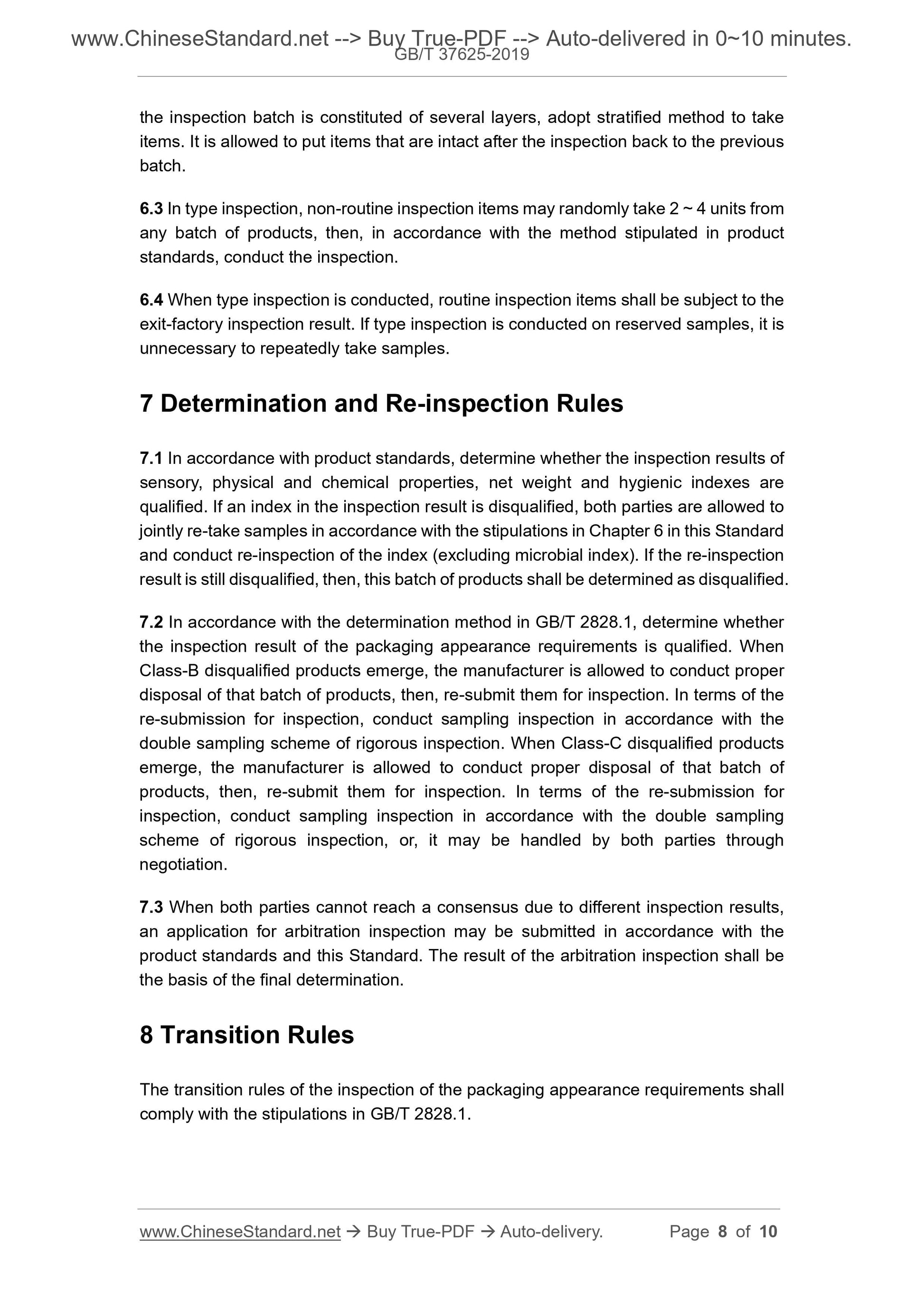1
/
of
5
PayPal, credit cards. Download editable-PDF and invoice in 1 second!
GB/T 37625-2019 English PDF (GBT37625-2019)
GB/T 37625-2019 English PDF (GBT37625-2019)
Regular price
$130.00 USD
Regular price
Sale price
$130.00 USD
Unit price
/
per
Shipping calculated at checkout.
Couldn't load pickup availability
Delivery: 3 seconds. Download true-PDF + Invoice.
Get QUOTATION in 1-minute: Click GB/T 37625-2019
Historical versions: GB/T 37625-2019
Preview True-PDF (Reload/Scroll if blank)
GB/T 37625-2019: Inspecting rules for cosmetics
GB/T 37625-2019
NATIONAL STANDARD OF THE
PEOPLE’S REPUBLIC OF CHINA
ICS 71.100.70
Y 42
Inspecting Rules for Cosmetics
ISSUED ON: JUNE 4, 2019
IMPLEMENTED ON: JANUARY 1, 2020
Issued by: State Administration for Market Regulation;
Standardization Administration of the People’s Republic of
China.
Table of Contents
Foreword ... 3
1 Scope ... 4
2 Normative References ... 4
3 Terms and Definitions ... 4
4 Inspection Classification ... 5
5 Batch Rules and Sampling Scheme ... 6
6 Sampling Methods ... 7
7 Determination and Re-inspection Rules ... 8
8 Transition Rules ... 8
9 Suspension and Recovery ... 9
10 Inspection and Sampling Rules of Cosmetics ... 9
Inspecting Rules for Cosmetics
1 Scope
This Standard stipulates the terms, definitions, inspection classification, batch rules,
sampling scheme, sampling method, determination, re-inspection rules, transition
rules, suspension, recovery, and selection of inspection methods for the inspection of
cosmetics.
This Standard is applicable to test for product approval, exit-factory inspection and
type inspection of various types of cosmetics.
2 Normative References
The following documents are indispensable to the application of this document. In
terms of references with a specified date, only versions with a specified date are
applicable to this document. In terms of references without a specified date, the latest
version (including all the modifications) is applicable to this document.
GB/T 2828.1 Sampling Procedures for Inspection by Attributes - Part 1: Sampling
Schemes Indexed by Acceptance Quality Limit (AQL) for Lot-by-lot Inspection
GB/T 8051 Sequential Sampling Plans for Inspection by Attributes
QB/T 1685 Requirements of Packaging Appearance for Cosmetic Products
3 Terms and Definitions
What is defined in GB/T 2828.1, and the following terms and definitions are applicable
to this document.
3.1 Test for Product Approval
Test for product approval refers to the inspection of the sensory, physical and chemical
properties, hygienic indexes, reliability1 and toxicology of new cosmetics before they
appear on the market.
NOTE: the objective of the inspection is mainly to assess whether the trial production
sample has reached the entire content of product standards or technical conditions
in the trial production stage. Product approval test report may be considered as
1 It is a generic term of tests that are conducted to understand, analyze, enhance and evaluate
products’ various properties in design, materials and process, and improve products integrity. Reliability
test items are determined by enterprises in accordance with the characteristics of their products, such
as: anti-corrosion challenge test, long-term stability test, transport packaging dropping test, etc.
one of the conditions of applying for appraisal and approval.
3.2 Routine Inspection
Routine inspection refers to the inspection of the sensory, physical and chemical
properties (excluding heat and cold resistance), net weight, requirements pf packaging
appearance, and total bacterial count, molds and yeasts in hygienic indexes for each
batch of cosmetics.
3.3 Non-routine Inspection
Non-routine inspection refers to the inspection of the heat and cold resistance in
physical and chemical properties, and other hygienic indexes other than total bacterial
count, molds and yeasts for each batch of cosmetics.
3.4 Item
Item refers to cosmetics whose basic unit is bottle, stick, bag and box.
3.5 Proper Disposal
Proper disposal refers to the process of picking out individual products that do not
comply with the requirements of packaging appearance from an entire batch of
cosmetics on the premise of not destroying the sales packaging.
4 Inspection Classification
4.1 Test for Product Approval
After product design is completed, conduct one-time inspection. If product’s properties
are safe and reliable, further inspection may be unnecessary.
4.2 Exit-factory Inspection
4.2.1 Before exiting factory, cosmetics shall receive batch-by-batch inspection by
manufacturer’s inspection personnel in accordance with the requirements of cosmetic
product standards. Those that pass the inspection may be allowed to exit factory.
4.2.2 Exit-factory inspection items are routine inspection items.
4.2.3 Through risk assessment, and the implementation of inspection, tests,
verification and confirmation at a proper frequency within a certain period of time, if the
accumulated relevant data can prove its applicability, some routine inspection items
(excluding total bacterial count, molds and yeasts) may be exempted during exit-
factory inspection.
4.3 Type Inspection
the inspection batch is constituted of several layers, adopt stratified method to take
items. It is allowed to put items that are intact after the inspection back to the previous
batch.
6.3 In type inspection, non-routine inspection items may randomly take 2 ~ 4 units from
any batch of products, then, in accordance with the method stipulated in product
standards, conduct the inspection.
6.4 When type inspection is conducted, routine inspection items shall be subject to the
exit-factory inspection result. If type inspection is conducted on reserved samples, it is
unnecessary to repeatedly take samples.
7 Determination and Re-inspection Rules
7.1 In accordance with product standards, determine whether the inspection results of
sensory, physical and chemical properties, net weight and hygienic indexes are
qualified. If an index in the inspection result is disqualified, both parties are allowed to
jointly re-take samples in accordance with the stipulations in Chapter 6 in this Standard
and conduct re-inspection of the index (excluding microbial index). If the re-inspection
result is still disqualified, then, this batch of products shall be determined as disqualified.
7.2 In accordance with the determination method in GB/T 2828.1, determine whether
the inspection result of the packaging appearance requirements is qualified. When
Class-B disqualified products emerge, the manufacturer is allowed to conduct proper
disposal of that batch of products, then, re-submit them for inspection. In terms of the
re-submission for inspection, conduct sampling inspection in accordance with the
double sampling scheme of rigorous inspection. When Class-C disqualified products
emerge, the manufacturer is allowed to conduct proper disposal of that batch of
products, then, re-submit them for inspection. In terms of the re-submission for
inspection, conduct sampling inspection in accordance with the double sampling
scheme of rigorous inspection, or, it may be handled by both parties through
negotiation.
7.3 When both parties cannot reach a consensus due to different inspection results,
an application for arbitration inspection may be submitted in accordance with the
product standards and this Standard. The result of the arbitration inspection shall be
the basis of the final determination.
8 Transition Rules
The transition rules of the inspection of the packaging appearance requirements shall
comply with the stipulations in GB/T 2828.1.
Get QUOTATION in 1-minute: Click GB/T 37625-2019
Historical versions: GB/T 37625-2019
Preview True-PDF (Reload/Scroll if blank)
GB/T 37625-2019: Inspecting rules for cosmetics
GB/T 37625-2019
NATIONAL STANDARD OF THE
PEOPLE’S REPUBLIC OF CHINA
ICS 71.100.70
Y 42
Inspecting Rules for Cosmetics
ISSUED ON: JUNE 4, 2019
IMPLEMENTED ON: JANUARY 1, 2020
Issued by: State Administration for Market Regulation;
Standardization Administration of the People’s Republic of
China.
Table of Contents
Foreword ... 3
1 Scope ... 4
2 Normative References ... 4
3 Terms and Definitions ... 4
4 Inspection Classification ... 5
5 Batch Rules and Sampling Scheme ... 6
6 Sampling Methods ... 7
7 Determination and Re-inspection Rules ... 8
8 Transition Rules ... 8
9 Suspension and Recovery ... 9
10 Inspection and Sampling Rules of Cosmetics ... 9
Inspecting Rules for Cosmetics
1 Scope
This Standard stipulates the terms, definitions, inspection classification, batch rules,
sampling scheme, sampling method, determination, re-inspection rules, transition
rules, suspension, recovery, and selection of inspection methods for the inspection of
cosmetics.
This Standard is applicable to test for product approval, exit-factory inspection and
type inspection of various types of cosmetics.
2 Normative References
The following documents are indispensable to the application of this document. In
terms of references with a specified date, only versions with a specified date are
applicable to this document. In terms of references without a specified date, the latest
version (including all the modifications) is applicable to this document.
GB/T 2828.1 Sampling Procedures for Inspection by Attributes - Part 1: Sampling
Schemes Indexed by Acceptance Quality Limit (AQL) for Lot-by-lot Inspection
GB/T 8051 Sequential Sampling Plans for Inspection by Attributes
QB/T 1685 Requirements of Packaging Appearance for Cosmetic Products
3 Terms and Definitions
What is defined in GB/T 2828.1, and the following terms and definitions are applicable
to this document.
3.1 Test for Product Approval
Test for product approval refers to the inspection of the sensory, physical and chemical
properties, hygienic indexes, reliability1 and toxicology of new cosmetics before they
appear on the market.
NOTE: the objective of the inspection is mainly to assess whether the trial production
sample has reached the entire content of product standards or technical conditions
in the trial production stage. Product approval test report may be considered as
1 It is a generic term of tests that are conducted to understand, analyze, enhance and evaluate
products’ various properties in design, materials and process, and improve products integrity. Reliability
test items are determined by enterprises in accordance with the characteristics of their products, such
as: anti-corrosion challenge test, long-term stability test, transport packaging dropping test, etc.
one of the conditions of applying for appraisal and approval.
3.2 Routine Inspection
Routine inspection refers to the inspection of the sensory, physical and chemical
properties (excluding heat and cold resistance), net weight, requirements pf packaging
appearance, and total bacterial count, molds and yeasts in hygienic indexes for each
batch of cosmetics.
3.3 Non-routine Inspection
Non-routine inspection refers to the inspection of the heat and cold resistance in
physical and chemical properties, and other hygienic indexes other than total bacterial
count, molds and yeasts for each batch of cosmetics.
3.4 Item
Item refers to cosmetics whose basic unit is bottle, stick, bag and box.
3.5 Proper Disposal
Proper disposal refers to the process of picking out individual products that do not
comply with the requirements of packaging appearance from an entire batch of
cosmetics on the premise of not destroying the sales packaging.
4 Inspection Classification
4.1 Test for Product Approval
After product design is completed, conduct one-time inspection. If product’s properties
are safe and reliable, further inspection may be unnecessary.
4.2 Exit-factory Inspection
4.2.1 Before exiting factory, cosmetics shall receive batch-by-batch inspection by
manufacturer’s inspection personnel in accordance with the requirements of cosmetic
product standards. Those that pass the inspection may be allowed to exit factory.
4.2.2 Exit-factory inspection items are routine inspection items.
4.2.3 Through risk assessment, and the implementation of inspection, tests,
verification and confirmation at a proper frequency within a certain period of time, if the
accumulated relevant data can prove its applicability, some routine inspection items
(excluding total bacterial count, molds and yeasts) may be exempted during exit-
factory inspection.
4.3 Type Inspection
the inspection batch is constituted of several layers, adopt stratified method to take
items. It is allowed to put items that are intact after the inspection back to the previous
batch.
6.3 In type inspection, non-routine inspection items may randomly take 2 ~ 4 units from
any batch of products, then, in accordance with the method stipulated in product
standards, conduct the inspection.
6.4 When type inspection is conducted, routine inspection items shall be subject to the
exit-factory inspection result. If type inspection is conducted on reserved samples, it is
unnecessary to repeatedly take samples.
7 Determination and Re-inspection Rules
7.1 In accordance with product standards, determine whether the inspection results of
sensory, physical and chemical properties, net weight and hygienic indexes are
qualified. If an index in the inspection result is disqualified, both parties are allowed to
jointly re-take samples in accordance with the stipulations in Chapter 6 in this Standard
and conduct re-inspection of the index (excluding microbial index). If the re-inspection
result is still disqualified, then, this batch of products shall be determined as disqualified.
7.2 In accordance with the determination method in GB/T 2828.1, determine whether
the inspection result of the packaging appearance requirements is qualified. When
Class-B disqualified products emerge, the manufacturer is allowed to conduct proper
disposal of that batch of products, then, re-submit them for inspection. In terms of the
re-submission for inspection, conduct sampling inspection in accordance with the
double sampling scheme of rigorous inspection. When Class-C disqualified products
emerge, the manufacturer is allowed to conduct proper disposal of that batch of
products, then, re-submit them for inspection. In terms of the re-submission for
inspection, conduct sampling inspection in accordance with the double sampling
scheme of rigorous inspection, or, it may be handled by both parties through
negotiation.
7.3 When both parties cannot reach a consensus due to different inspection results,
an application for arbitration inspection may be submitted in accordance with the
product standards and this Standard. The result of the arbitration inspection shall be
the basis of the final determination.
8 Transition Rules
The transition rules of the inspection of the packaging appearance requirements shall
comply with the stipulations in GB/T 2828.1.
Share
